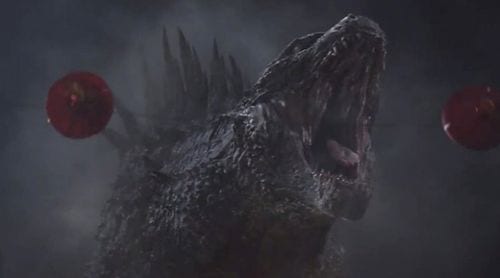Most franchises today don't like to acknowledge their own histories. It makes regurgitating the same film over again much trickier, leaving us with "the reboot". The new Godzilla instead uses its own history as a comeback springboard, acknowledging that the original Japanese movies occurred (okay, maybe not all 28 of them or the world wouldn't be so surprised that monsters exist) but that the truth was buried as Godzilla went out to sea in the 1950s. Enter our three inciting characters from different countries (British Sally Hawkins, Japanese Ken Watanabe, and American Bryan Cranston) making upsetting discoveries in 1999.
[MILD SPOILER] They all have deep-rooted histories with either the Godzilla cover up or the strange infrequent electro magnetic pulses from what they believe is a monster spore which may or may not be related to the Godzilla legend. Tragedy strikes the American when his wife is killed in a freak power plant accident leaving his son motherless, which ends the movie's prologue. [/SPOILER]
 Cut to: 2014. The American's son is now a bomb expert soldier (Aaron Taylor-Johnson, still easy on the eyes, still somewhat lacking where the charisma is supposed to go). He has returned to Japan to take his crazy conspiracy theorist father home when, by the father's design, they end up back at the scene of their shared original tragedy. Naturally it's just that night when all hell breaks loose (you know how these things happen). The long dormant spore suddenly activates and what looks like a behemoth mutant cockroach emerges and escapes, presumably to wreak immediate havoc in a nearby metropolis.
Cut to: 2014. The American's son is now a bomb expert soldier (Aaron Taylor-Johnson, still easy on the eyes, still somewhat lacking where the charisma is supposed to go). He has returned to Japan to take his crazy conspiracy theorist father home when, by the father's design, they end up back at the scene of their shared original tragedy. Naturally it's just that night when all hell breaks loose (you know how these things happen). The long dormant spore suddenly activates and what looks like a behemoth mutant cockroach emerges and escapes, presumably to wreak immediate havoc in a nearby metropolis.
The rest of the film, then, becomes a chase and hunt movie as the scientists and soldier pursue this MUTO ("massive unidentified terrestrial organism") from Japan to the US. (For once, it's worth noting, New York City is not the site of mass destruction; we get to live this time!). Along the path of destruction, the heroes realize that Godzilla has reemerged from his decades of exile at the depths of the ocean and appears to also be chasing the Muto. The genre trappings, story beats and themes are nothing new, at all. It's hard to be new with sixty years of your own franchises history within the very populated subgenre of sci-fi / horror known as the monster movie. I also wish I could be super enthused about the human cast, who get a lot more screen time than you'd expect, but despite a collection of very fine actors there's not much in the way of character specificity: The men have little to do other than sell fear mixed with their passion in their heroic convictions (Aaron Taylor Johnson is rescued for awhile from film carrying duties by a team of soldiers – hello Victor Razuk!) he meets in mid chaos) and the women have even less to do, working intense variations of worried for the world / worried for their men and in Sally Hawkins' case worried for Godzilla.
What's fresh and redemptive, though, about this particular Godzilla is the artistry and confidence of the young director Gareth Edwards and his team (the cinematography, visual effects, production design, and original score are all super). Edwards made his name on the inventive strength of his low budget alien invasion debut (Monsters, 2010) but he never seems to be straining for effect or letting his new colossal budget squash his storytelling instincts with a Godzilla sized foot. He doesn't let the effects do the work for him. He goes for gorgeous minimalism whenever possible: silhouettes of monsters in the fog, telltale shadows on broken buildings, and some of the most beautiful strokes of color I've ever seen in a blockbuster. That's especially true of a dreamy sequence late in the film involving paratroopers. It's weird to call a movie with typical monster thrills (the crowd goes wild whenever Godzilla unleashes his best fighting tricks) "beautiful" but it is just that. Godzilla is more like a moving painting than a motion picture at times.
The first of many memorable images in this crazy/beautiful blockbuster is the title card. "Godzilla" with all the hysteria and nostalgia the name provokes, emerges faintly on a white screen obscured only by drifting ashes. The score makes almost no fuss about it. The world's beloved embodiment of its own atomic age anxiety went boom long ago and this king of monsters disappeared. The title card is quiet and surprisingly funereal. But the movie that follows is no elegy for the monster movie, childhood awe at massive animals, or even for old school blockbuster filmmaking. Gareth Edwards might well be a new mad genius Doctor Frankenstein because this Godzilla (2014) is a bonafide resurrection of all of those things. The only thing it's going to bury are the basic bitches that follow it.
Kick back and watch with jaw dropped. Chew your popcorn like it's a tasty skyscraper that got in your way.
Nathaniel Rogers would live in the movie theater but for the poor internet reception. He blogs daily at the Film Experience. Follow him on Twitter @nathanielr.





